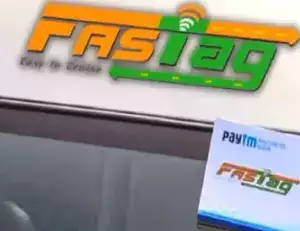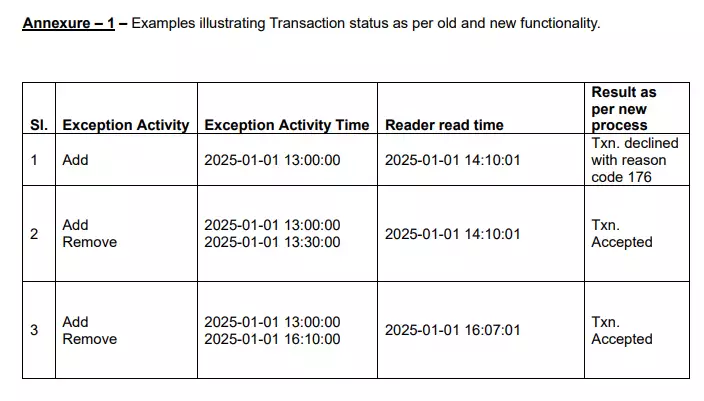FASTag rule change: Travellers will only have 70 minutes to act to cross a toll plaza without hiccups for blacklisted account

Read below to know what the new FASTag balance validation rules mean for you and stay updated so that your highway journey is smooth.
What is the new rule about FASTag validation?
NPCI, in a circular dated January 28, 2025, said, “Transactions that are presented shall be validated based on reader read time and the time at which the tag is placed under hotlist/low balance/blacklist. Transactions presented on tags which are not active for more than 60 minutes prior to reader read time and up to 10 minutes after reader read time shall be declined with reason code 176 ...This shall be implemented effective February 17, 2025.”What does this new rule about FASTag mean?
There are typically two states of a vehicle w.r.t the FASTag system: 1) whitelisted and 2) blacklisted vehicles.Blacklisting can happen for varied reasons, such as
- Insufficient balance
- Pending KYC updation
- Mismatch in chassis number and vehicle registration number as per RTO records
60 minutes prior to FASTag read time and 10 minutes after read time
The FASTag that is hotlisted or is on the exception list will have a total 70-minute window to remove the exception, whether it is low balance, KYC updation, or registration number mismatch.“A FASTag transaction will only be declined if the tag has been on the hotlist/exception list for more than 60 minutes when the user arrives at the toll plaza and remains on the list for at least 10 minutes after leaving. Otherwise, the transaction will be processed. This provides a grace period for users to recharge their FASTags, preventing unnecessary inconvenience,” FinTech lawyer Utkarsh Bhatnagar, Partner, Cyril Amarchand Mangaldas, said.
Arun Moral, MD, Primus Partners, explains this above rule using three examples:
- Scenario-1: “If the FASTag owner gets blacklisted at T1 hours and once the vehicle gets read at the toll plaza, the transaction would be declined (with reason code 176), and 2x the toll-fee would be recovered from the user due to blacklisting.
- Scenario-2: If the FASTag vehicle gets read at a toll plaza at R1 hours and if the vehicle user was under backlisting, and the FASTag was recharged either 60 minutes before R1 or 10 minutes after R1, then the transaction is accepted and only 1x toll fee is collected instead of 2x toll fees.
- Scenario-3: If the FASTag owner gets blacklisted at T1 hours and crosses the toll plaza, then he will be charged 2x the toll fee due to the FASTag blacklisting status; however, if the vehicle user recharges the FASTag within 10 minutes from the time of it being read at the toll plaza, then the owner is allowed to get a refund of the penalty charge of 2x the toll charge, and 1x thetoll fee would be charged to the whitelisted FASTag account.”
Table showing how the new rule will be implemented:

What might be the impact of this new rule about FASTag validations for consumers?
We have asked various fintech lawyers and experts about the possible impact. Here’s what they said:Arun Moral, MD, Primus Partners: “This would bring a great relief to toll plaza users, particularly those who are charged a penal amount of 2x the toll fee due to blacklisting of FASTag; there is a chance for such users to claim a refund of the penal charge if they recharge their FASTag account within 10 minutes of being read at the toll plaza. NPCI, IHMCL, and NHAI get additional data points with (reason code 176) capture, which can potentially differentiate earlier consolidated declined transactions with reasons and support in the recovery management process.”
Vipul Jai, Partner, PSL Advocates & Solicitors: “For consumers, this change means that managing the FASTag balances and status updates in advance is crucial to avoid unexpected toll payment failures. If a tag is marked as low balance or blacklisted for over an hour before reaching the toll plaza, the transaction will be automatically rejected, even if funds are added at the last minute. Similarly, if a tag is moved to the exception list just after passing the toll scanner, the payment will also be declined. This adjustment is likely to be aimed at enhancing the security and reliability of transactions, ensuring that payments are only processed from active and valid tags.”
“While this rule improves system integrity and reduces fraudulent transactions, it may also cause inconvenience for unaware consumers. Those who frequently reload their FASTag balance at the last moment may experience declined transactions and possible delays at toll booths.”
Abraham Koshy, Counsel, MVAC Advocates & Consultants: “The FASTag rule is a 60-minute rule that will decline transactions of FASTag accounts that have been inactive (due to hotlisting, blacklisting, or low balance) for more than an hour before reaching the toll plaza. While this may initially seem restrictive, the new system aims to create a smoother toll experience by drastically reducing unauthorised transactions and disputes. The other is a 10-minute rule that will decline transactions if the FASTag account is blacklisted within 10 minutes after the toll transaction.”
“This will also ensure users are more diligent about maintaining adequate funds and keeping their FASTag accounts active to avoid any interruptions in their toll plaza transactions. Both the above changes are a welcome move that will ultimately help manage the congestion at tolls and create a more organised system on the highways.”

